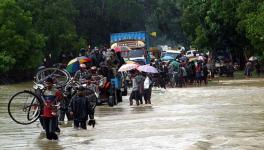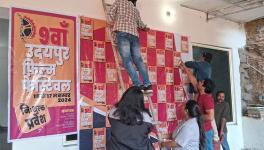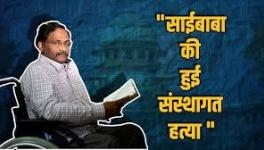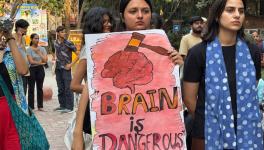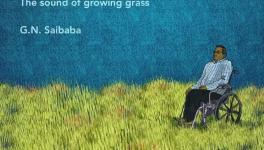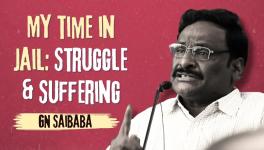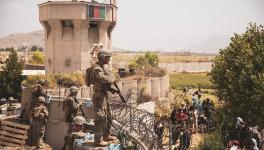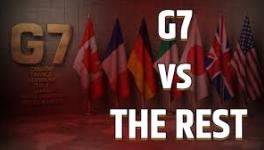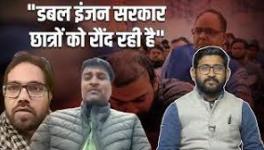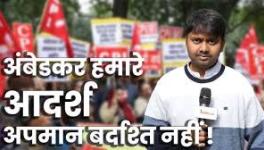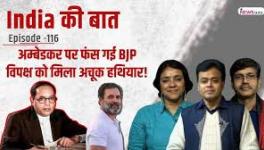Was Trial Judge Who Convicted GN Saibaba Biased? We Will Never Know
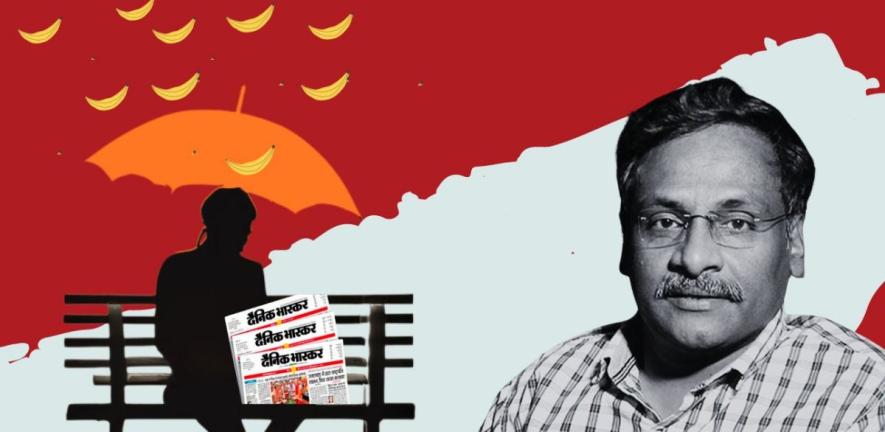
G N Saibaba (Image: The Leaflet)
The Nagpur Bench of the Bombay High Court heard the appeal against the conviction of Prof. G.N. Saibaba and five others, twice. In both the judgments, it set aside the conviction.
The hearing was held in a fully packed courtroom with, at times, hot-tempered exchanges of strong arguments. Needless to say the atmosphere was terribly tense.
However, one proposition of Pradip Mandhyan turned out to be so hilarious— although hard-hitting— that the entire courtroom would burst into laughter every time it was mentioned. He pointed out that one of the most incriminating items was missing.
And the missing article was a banana. Yes, a banana.
The ten-year-long ordeal of the six ‘Urban Naxals’ ended on March 5, 2024. Pronouncing the judgment in the court full of lawyers and journalists, the otherwise calm and soft-spoken Justice Joshi seemed to be in a totally different mood.
His voice firm, resolute, determined and unusually loud, conveyed that they were delivering well-deserved justice by overturning the conviction.
Simply put, the judgment said what we lawyers often say: “There was nothing in the matter”.
Nothing worth a conviction.; in fact, nothing worthy even of a trial.
Charges ‘serious’ enough to be hospitalised
The conviction by the trial court had come as a surprise to everyone, except the police. The case was made sensational right from the first day.
While the first round of hearings in appeal before the high court went mostly unnoticed by the national media, its judgment created uproar. Even before the ink could dry, the State went in appeal in the Supreme Court on the very same day.
The then to-be Chief Justice of India, Dr D.Y. Chandrachud, refused an urgent listing. However, within a short time, the Supreme Court convened a special Bench on a Saturday morning to hear the matter.
The specially constituted Bench consisting of Justices M.R. Shah and Bela Trivedi gave an unprecedented stay on the acquittal. Additionally, it refused to grant medical bail or even house arrest to the ailing, 90 percent disabled, wheelchair-bound professor.
What was otherwise a one-sided case was turned into a highly contested one by the State, as it fielded some of its best pleaders. The best of lawyers advanced some of the most novel technical arguments.
Bail applications were opposed tooth and nail. Although all six appellants were on bail during the trial, their bail, pending the appeal, was rejected. In one of the hearings, the special prosecutor even admitted, on record, that there is no act of terrorism, attributed, proved or alleged against any of these persons, yet bail was rejected.
When Saibaba applied for parole to visit his ailing mother, even that was rejected. The charges were ‘serious’; the love of a son for his mother could wait.
Over seven years, at least four special prosecutors were appointed. When the bail application of Professor Saibaba was about to be moved, his lawyer Surendra Gadling was arrested and booked under the Unlawful Activities (Prevention) Act, 1967 (UAPA) in the infamous Bhima Koregaon–Elgar Parishad case, and has been in jail ever since.
During every hearing, high-rank police officers would sit in the courtroom. In the first round, when the investigating officer was not satisfied with the arguments made by the senior counsel appearing for the State, he decided to make some arguments himself to explain how “Urban Naxals” operate.
When the court asked a very basic question at the outset, he was left speechless, and then quietly vanished from the courtroom during the lunch break. In the second round, the State changed the special counsel.
In both rounds of appeal that took place in the high court, of the various points argued, one of the major contentions was that of “bias of the trial judge”.
Assailing the judgment of the trial court, advocate Pradip Mandhyan would strenuously call it the outcome of a “perverse, corrupt and dishonest” act on the part of the presiding officer.
He had all the reasons to say so. Apart from what has been held in the judgment of the high court on the nature of evidence, a few facts would reveal the real basis of this argument.
1,000 pages of perversity, corruption and dishonesty
The judgment rendered by the trial court, which can even be seen on various online platforms, runs into about a thousand pages.
After holding all six persons guilty, in Paragraph 1,013, the learned sessions judge says, “[I]n my opinion, the imprisonment for life is also not a sufficient punishment to the accused but the hands of the court are closed with the mandate of Section 18 and 20 of UAPA and in my opinion it is a fit case to award sentence of life imprisonment to accused.” (sic).
Meaning thereby, that the court wanted to sentence them to death, but its hands were closed (tied) for the law did not provide for such punishment under the invoked provision.
The timeline of the case, if seen, will bear out that the statements of the accused under Section 313 of the Code of Criminal Procedure were recorded well up to January 9, 2017.
Thereafter, oral submissions by the counsels began, which stretched for about a month. Ultimately on February 9, 2017, the defence filed its written note, and the matter was reserved for judgment.
Two weeks later, i.e., on February 28, 2017, the matter again appeared on the board, for the prosecution wanted to cite some judgments.
In less than a month since reserving the judgment, at 1 p.m. on March 7, 2017, the sessions court at Gadchiroli pronounced the judgment running into 827 pages, holding all six guilty.
All six were called upon to make submissions on sentences to be awarded. The defence counsel, Surendra Gadling, refused to make any submissions. Prashant Rahi, Hem Mishra, Vijay Nan Tirki and Saibaba also refused to make any submissions. No one believed that this was a case where a conviction could have been given.
By 3 p.m. on the same day, the learned judge pronounced the sentence of life to five and 10 years to Vijay, with reasons running into 14 pages. Each one of them was handed over a copy of the judgment right then and there, i.e., prints of about 5,000 pages.
Rendering such a bulky judgment in less than 30 days is not impossible. It can be done, of course. But that alone need not raise eyebrows.
In contrast, in the first round of appeal, the high court took about 15 days to render its judgment of about 100 pages restricted to the issue of sanction, while in the second round, it took nearly 175 days to render a 293-page verdict.
The trial court felt life imprisonment was not sufficient because it blamed the Communist Party of India (CPI) (Maoist) and the Maoist movement in India for the non-industrialisation of the Gadchiroli district in Maharashtra.
The trial court held, “Gadchiroli district today is same as it was in the year 1982 and for that the accused no. 1 to 6 and members of banned organisation CPI (Maoist) and its frontal organisation Revolutionary Democratic Front (RDF) are responsible.”
It gave various statistics that were never cited at the Bar and the source of which is mentioned to be “government records”. The trial court held that Professor Saibaba, though 90 percent disabled, is mentally fit, and is a “think tank” and “high-profile leader” of CPI (Maoist).
To draw these conclusions and not give a death sentence, the judge accepted the case of the prosecution, not just in its entirety, but even over and beyond what it was.
The trial court referred to material that none of the prosecution witnesses had even uttered in their depositions.
From the hoard of material that was “dumped” by the prosecution in the form of so-called electronic evidence, the trial court pulled out a variety of unique incriminating material. One of which was a “banana”.
Not just a banana, a newspaper and an umbrella too. The court had found from the cache of literature one particular newspaper article which mentioned that Naxals supposedly carried a “banana, umbrella and newspaper” as code to identify each other (i.e., to identify highly secretive Maoists).
The trial judge held, “[I]n order to identify the members of CPI Maoist or RDF organisation by an unknown person the unique identification, i.e., Banana, Umbrella and Newspaper were used.”
Did the investigating officer call it the modus operandi of ‘Urban Naxals’? The answer is no. Did any witness of the prosecution say that this was the modus operandi? The answer is another no. No one said it, no one hinted about it.
Where did it come from then?
One journalist had written it in one of her articles.
Was she examined as a witness by the prosecution? No.
However, the item became a fatal piece of ‘evidence’ for the defence, in that the journalist in question had written in her article that she carried these three items to meet Naxals. Hence proved that these items are incriminatory articles. Possession of which, inter alia, proved a person to be a Naxal for whom life imprisonment was not punishment enough.
The next question would be: Were any of the accused in the case caught possessing any of these three items? The answer is no, not really. But Pandu Narote was found carrying an umbrella when he was arrested in August, a season of rains.
Prashant Rahi, arrested about a week later, was found carrying not just a full, completely intact newspaper but cuttings of another newspaper as well.
(Maybe he just wanted to ensure that in case he lost the newspaper, he could flash around cuttings to attract his fellow secretive Naxals hiding in the dense forest.)
Was anyone apprehended carrying a banana? No.
Perhaps the prosecution could have made an argument that the incriminating evidence, i.e., bananas, were eaten by these persons and, therefore, they have committed another offence, that of destroying evidence.
But that was also not to be. The prosecution did not utter a word about this so-called modus operandi and the utterly banal but most incriminating items.
The learned judge, however, held that since Prashant Rahi was found possessing a newspaper, “hence, in peculiar facts and circumstances of the case finding of the daily newspaper Dainik Bhaskar can be considered as incriminating evidence against accused no. 4 Prashant Rahi.”
Figments of panchnamas
The search, seizure and arrest of Prashant Rahi is another episode in which the court did not find any fault. The prosecution alleged that they got secret information that the second messenger (Prashant Rahi, the first one being Hem Mishra) was going to be at Devri, a remote town in Gadchiroli, on September 1, 2013, to meet senior Naxals to pass on some secret message.
Accordingly, a team that was already in the area searching for one Pahadsing was given this information. Who gave the information to the search party? Neither the recipient stated it, nor the giver stated it.
Anyways, the information was that an accused in the case was in the Raipur area and the search party should look for him. Did the information contain a physical description of the person to be looked for? Not stated. Did they know the name of the accused? Not stated.
Accordingly, the prosecution claim went on, the search party went to Raipur wherein they found out that the accused had gone towards Devri in a four-wheeler. So, they went to Devri.
At Devri, two persons (Prashant Rahi and Vijay Nan Tirki) were intercepted at “a crowded junction”. They were taken in custody (at 4:30 p.m. on the same day, i.e., September 1, 2013) as they were in a “suspicious condition”.
They were found to be possessing “Maowadi” (Maoist) and “Naxal literature”. Upon merely being asked, they revealed their true identity. Then, as per directions of the sub-divisional police officer (SDPO) Suhas Bawache, they were brought to Aheri at 5 a.m. the next day, i.e., September 2, 2013. No arrest or seizure panchnama was drawn on the spot or at Devri. It came to be drawn at Aheri the next day.
The panch witness to this seizure stated that he had gone to the police station for this panchnama on September 2, 2013 in the evening at 5:45 p.m.
It was during this search again that Prashant Rahi was found possessing Maoist literature. Meaning that after about 24 hours since his custody, he continued to possess the said Maoist literature.
(Perhaps the police party found incriminating material with them at Devri Chichgad T point, read it and returned it earnestly to the accused for it belonged to them, and seized it the next day at their leisure. What was the tearing hurry?)
Now what was found in the possession of the accused after 24 hours of custody is equally interesting. A wallet containing some cash, a PAN card, a driving license, 12 visiting cards, of course, a copy of the newspaper Dainik Bhaskar, one transparent plastic folder containing four empty envelopes, photocopies of Dainik Bhaskar (newspaper cutting), a few blank papers, a few prison and court-related documents and “three English stapled Naxal organisation-related documents”.
(These three English-stapled Naxal organisation-related documents could not be traced in the hearing before the high court, though counsels on both sides searched for them repeatedly and fervently).
Even though the hands of the court were “closed” by provisions of law, saving the accused from the gallows, it did not stop the court from dispensing with the requirement of proof beyond reasonable doubt and extending the benefit of probability to the prosecution. It held, “Version of prosecution appears to be more probable than the defence.”
In short, a terrorist on a mission carrying extremely sensitive secret information that was to be given to the senior terrorists hiding in the forest was so naïve that he carried with him all his identity documents.
He did not just carry one identity card, but multiple ID cards, along with his train tickets and visiting cards. He did not make an effort to conceal his identity and on merely being asked was polite enough to reveal his true name along with his other aliases.
The secret information can only be related to court and prison documents, or newspaper cuttings of which photocopies were found kept in a transparent blue plastic folder.
No one knows what was in those stapled pages. The trial court has not commented on it in its judgment. All said, the fact remains that Dainik Bhaskar, inter alia, sealed the fate of Prashant Rahi.
Similarly, Pandu Narote and Mahesh Tirki, who were allegedly on a secret mission to transport Hem Mishra secretly to senior Naxals in the remote forest, were found carrying all identity documents.
Pandu was found possessing not just one identity document, he was carrying his domicile certificate, caste certificate, bank passbook, his own birth certificate, the birth certificate of his daughter, ration card, driving licence, election identity card, school leaving certificate and a copy of the Lokmat newspaper.
Mahesh carried propaganda material of Naxals, i.e., three pamphlets, all different, and of course an election ID card.
Hem Mishra was carrying an ATM Card, PAN card, election ID card, university library identity card, yatri card, railway ticket from Delhi to Ballarshah, one Kodak digital camera with a charger, a 16GB memory card, and a copy of the Sahara newspaper.
None of these three tried to conceal their identity. They gave away their true names right away. They did not even try to run away upon being intercepted.
The 16GB memory card which contained “vital Maoist communication and other Maoist documents in encrypted form with the intention to further activities of terrorist organisation CPI Maoist” to be handed over to a senior terrorist in the forest, contained some of Hem Mishra’s own personal photographs, photographs of Professor Saibaba and his family members.
It also contained a few movies— really boring ones. Not even worth a name. Among all these contents, it was stated that there were incriminating documents. They were incriminating solely because they were protected by a password.
There is not a whisper as to what efforts were taken to decrypt the password. But since they were password protected, they were termed incriminatory. Could they be bank e-statements? Or income tax e-returns? No one knows.
A search to seize
The seizure at the house of Professor Saibaba is another episode. Around 50 high-ranking officials from Gadchiroli and Delhi were party to this sensational raid. Professor Saibaba’s house was located in Delhi University Campus, surrounded by houses of many professors and university employees. Yet the witness chosen was an illiterate poor barber.
Admittedly, Professor Saibaba and the panch were locked outside the house while the search was going on. The panch himself requested that some other educated person be made a panch witness for he is illiterate but that was not accepted.
On the other hand, Professor Saibaba appealed in writing to take a search in the presence of professors or lawyers who were present, but that too was denied.
When the witness admitted being kept outside the house while the search was ongoing, the court found exceptional reason to give no importance to that point.
The judge, in Paragraph 230 holds, “It is to be noted that this witness is illiterate. He cannot read and write the English language and his cross-examination was held the whole day, that too by an eminent lawyer having standing practice of more than 25 years and this witness might have been frightened because of the atmosphere…
“Hence, a stray admission … that he and the accused Saibaba (were) kept outside the house while taking house search … is not a ground to discard version of the prosecution witness.”
Back to the day of the raid at Professor Saibaba’s house. Admittedly, about 50 police officers were inside the house, and along with them were two cyber experts. Complete videography was done of the seizures. After hours of search and seizure, they gathered all the electronic material.
The seized material was taken in a bag and the police left it. Just like one goes to a vegetable market, stuffs various purchases in the bag and goes home thinking about which dish to cook from so many options.
No hash value was drawn or given as the law requires, nor were the devices sealed to avoid interference or manipulation. I repeat, there was no sealing.
Yes! The most basic thing that is done in search and seizure— sealing. Putting seized articles in a cover, and then sealing it with the signature of the panch witnesses, police officers, etc. That was not done. They only drew an inventory, and, like I said, placed the items in a bag and left.
This happened in the presence of two ‘cyber experts’. These two ‘cyber experts’ could not differentiate between a Bluetooth device and a pen drive, hence they recorded that the attachment to the laptop was a pen drive.
This mistake was repeated even at the Aheri police station, where another ‘cyber expert’ called the attachment to the laptop a pen drive. It was, however, in the analysis report that the device attached to the laptop was found to be a Bluetooth device.
Surendra Gadling, cross-examining the investigating officer, asked him why the videography of the raid had not been filed on record. Is it because in the videography police officers were seen planting hard discs and other materials?
The witness said, a CD of the videography was not provided by the Delhi police, even though he had reminded them four times.
How was the reminder given, written or oral? Answer: Oral.
In the high court, when the Bench asked the special counsel to procure that video recording and show it to the court, the prosecution said it would get it. However, the video recording never came.
None of these created any doubt in the mind of the trial court. They were all “stray” incidents that could not divert the court’s single-minded focus from finding the accused guilty. Not fatal to the prosecution, owing to cross-examination by an eminent lawyer, who is now in jail on more ridiculous, trumped-up charges.
Non-cognisance of ill-treatment
This apart, the evidence of the judicial magistrate first class who recorded the alleged confession of Pandu (now deceased) and Vijay makes for an even more disheartening read.
Pandu and Vijay had both addressed a detailed letter to the magistrate complaining about the ill-treatment that was meted out to them which was not acted upon. During the cross-examination when the judicial officer was countered with it, he gave the following reply. Try making sense of it.
“None of the accused had made an application before me about the ill-treatment by police during the investigation. It is true that the accused in the present case made a written application before me about ill-treatment meted out to them after recording their statement.
“I had not taken any action on the basis of their written application. I did not call any report from the police officer. I did not take cognisance of their complaints.
“I did not take cognisance because before recording the confession when it was being recorded, I came to know that said the confession was voluntarily made and an application for ill-treatment was made subsequently hence, I did not take any cognisance.
“Now, I am shown the complaint made by the accused in the present proceedings regarding ill-treatment. The complaint bears my signature about receipt of the same. It is marked at Exh 292. (document exhibited as it is referred by defence.)
“On the said application on October 8, I called say of APP (sic). As the said application was received through an envelope, I directed my staff of the court to file it with case papers and there was an endorsement to that effect on it.
“But the clerk of the court did not put it before me. On October 8, I called say of APP at that time the said application was not attached to the case papers. When the application was put before me on the third and eighth, I had gone through the entire contents of the application.
“I had not taken any action on the said application. As the application was not again put up before me after obtaining say of APP, I did not pass any order. The said application was not put up before me after obtaining say of APP after my Order on October 8.
“I did not call the say of police. As it was a complaint against the police, I did not call the say of APP. Not true to say that as the said confession was recorded under the inducement and threat of police, I did not call the say of police.
“When there is a complaint disclosing commission of cognisable offence, then the magistrate has to take cognisance of the offence. It is not true to say that in order to assist the investigation, I did not take cognisance of the offence in respect of allegations made at Exh. 292.
“During my tenure at Aheri I used to reside in the quarter constructed by police officers. Witness volunteers that as there was no judicial assigned quarter and he had made an application to the then PDJ for assigning quarter and as the whole Gadchiroli district is a Naxalite area for security purposes, the quarter was assigned to me. Hence I was residing there.”
Who will judge the (mis)judge?
Also, see the chronology of events. Hem Mishra is declared arrested on August 22, 2013. National media carries the news. Prashant Rahi’s is declared arrested on September 2, 2013. The national media carries the news.
Before these two arrests, there was a report in a national newspaper hinting that Professor Saibaba was on the radar of security agencies. In view of this report, colleagues of the professor addressed a letter to P. Chidambaram, the then Union Home Minister, suspecting mischief at the hands of security forces.
In these circumstances, is it believable that an intellectual person of the calibre of Professor Saibaba would keep all incriminating materials in his own house, in his laptop, in his hard disc, so that it becomes easier for police to nab him and fix him for good?
A person having the slightest of guilt on the smallest of hints will put himself on guard. He will watch his back. Erase all traces. Clean himself to the extent possible. Make desperate attempts to destroy any and every evidence. That would be natural conduct.
But there was nothing natural in this case.
Such being the case, where arrest, search and seizure were the most important factors, bereft of any evidence the court saying that life imprisonment was not sufficient gives reason to say that the judicial officer was biased, if not motivated.
Could it have been an error or ‘errors’, when records are overwhelmingly full with all reasons to not believe the prosecution’s case? Could it have been ignorance of the law, when reading in evidence what is not brought on records? Could it have been a lack of judicial approach? What could it be?
Sadly however, the argument of Pradeep Mandhyan that the findings and judgment of the trial court are “perverse, dishonest and corrupt” remain undecided, and will remain undecided, forever.
The writer is a lawyer based in Nagpur. The views are personal.
Courtesy: The Leaflet
Get the latest reports & analysis with people's perspective on Protests, movements & deep analytical videos, discussions of the current affairs in your Telegram app. Subscribe to NewsClick's Telegram channel & get Real-Time updates on stories, as they get published on our website.










